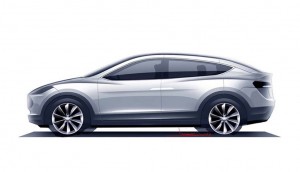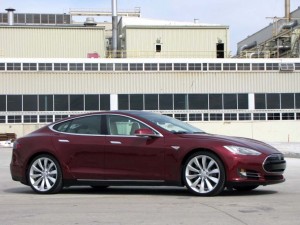
Tesla plans to add an assortment of additional models, including a downsized battery crossover to compete with the likes of the BMW X3.
It’s struggling to overcome quality problems and meet bulging backorders for its first mainstream model – but that apparently hasn’t slowed down Tesla Motors’ ambitious plans.
The maker reveals it is already working up an assortment of newer models – and that it will announce, next week, what it has dubbed the “Tesla Supercharger,” expected to be a network of advanced battery charging stations designed to eliminate motorists’ concerns about battery range.
The new stations might look a bit like “alien spaceships,” suggested Tesla founder Elon Musk. Meanwhile, one of the firm’s primary investors has told his Detroit competitors they should give up on battery cars and work on “flying cars.”
The California battery-car start-up has been struggling to ramp up production of the Model S, its first serious vehicle, since the assembly line in Fremont, California started rolling two months ago. Tesla officials have confirmed they likely won’t approach their production targets until the end of the year, meaning a backlog of orders well into 2013.

The first production Tesla Model-S. The maker has had more problems than expected getting more of the sedans off the line.
But one of the maker’s key investors, Tim Draper, downplayed that issue during an appearance in Detroit. In fact, he confidently asserted that Tesla is now so far along that its Detroit competitors should “wake up” and move onto something else.
“Create a flying car,” suggested Draper, the co-founder of the $6 billion Silicon Valley venture capital firm Draper Fisher Jurvetson – which has also put money behind Skype and SpaceX, the latter also founded by Tesla’s chairman and CEO Elon Musk. “Create something different because you’ve lost the electric-car battle. See if you can win another.”
The brash comments, made during the Techonomy conference sponsored by Detroit’s Wayne State University, were dismissed by several Big Three officials working on General Motors, Ford and Chrysler battery car programs.
“They can’t even screw their cars together right,” said one GM battery car insider, asking to remain off the record. Initial vehicles rolling out of the Fremont plant – previously a facility operated as part of a GM-Toyota joint venture – have suffered from a variety of start-up issues including excessive body panel gaps.
Tesla now hopes to have 5,000 Model S sedans produced by year-end, with production planned to reach 15,000 in 2013. By comparison, GM sold about 13,500 Chevrolet Volt plug-in hybrids during the first eight months of 2012 and, at the current pace, will likely nip the 20,000 mark by year-end. But that’s a significant shortfall from the maker’s original 45,000 target.
The Model S covers a price range of $50,000 to more than $100,000, depending upon options. That includes a choice of three different battery packs delivering ranges of approximately 160, 230 or 300 miles.
Even before the official production launch in July, Tesla revealed plans to launch its second mainstream battery-electric vehicle, the Model-X crossover, in mid-2013.
But the product program won’t stop there, Tesla founder Musk revealed. A downsized sedan is in the works for 2015. With a similar hatchback design, he suggested it will be a “scaled-down” version of the Model S. He has hinted that it would be called the Model E but now appears to be looking for an alternative name.
Meanwhile, Musk told Wired magazine that at least two more models are under development, including a follow-up to the battery-car company’s first, limited-edition offering, the Tesla Roadster.
Also on tap is a crossover smaller than the upcoming Model X that will directly target vehicles in the BMW X3 class. “We’ll do the X3 equivalent and then a Roadster follow-up in parallel,” said Musk, adding that the two should be ready for market around 2016.
He didn’t provide other details, so it’s not clear if the smaller CUV will use the unusual, vertically opening “falcon door” design that Tesla has developed for the Model S.
The next-generation Roadster will not use a Lotus-based platform as the original did. Nor is it going to carry the same, roughly $100,000 price tag, Musk stressed, adding that, it will boast “supercar performance, but not supercar pricing.”
Toyota recently confirmed it will work with the California maker to develop a new high-performance sports car and the new Tesla model is likely to be a spin-off version of that offering.
Despite the bravado of Tesla officials and investors, most analysts believe the maker will have a tough time gaining traction, especially with so many mainstream competitors to go up against. But the skeptics have been softening their criticism, with Tesla stock climbing fast as a result. It jumped $2.15 a share on Monday to close $32.54, its best performance since April.
Investors, analysts – and potential battery-car buyers – will likely be watching closely next Monday evening when Tesla formally unveils its new Supercharger project. First hinted at by Musk, last January, it’s expected to be a network of fast-charging facilities that will likely offer the ability to get a near-empty battery up to about 80% of range within 45 minutes.
Another possibility is that Tesla will offer battery swapping, so an owner could simply swap out a discharged battery set for a completely recharged pack within minutes. It’s not clear if all three of the battery packs on the Model S would be included.
Meanwhile, with Musk a serious fan of solar power it is possible the system will rely on at least some solar charging capabilities.
And there will likely be some services offered at the Supercharger centers to keep Tesla vehicle owners occupied while waiting.
For now, Musk is only suggesting that the facilities will “feel like alien spaceships landed at highway rest stops.” They are expected to first open in key stretches of Southern, Central and Northern California though Tesla may well announce plans to expand to other parts of the country going forward.
